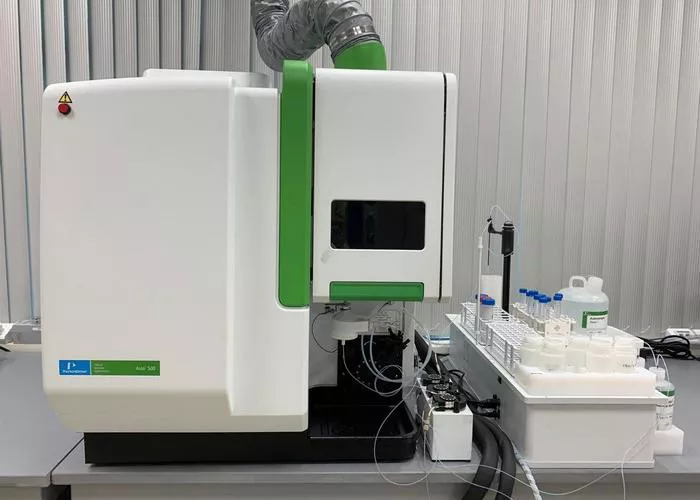Infrared (IR) spectroscopy is a powerful analytical technique used in various scientific and industrial applications. At the heart of this technology lies the IR spectrometer, an instrument designed to measure how molecules interact with infrared light. This interaction provides valuable insights into the molecular composition and structure of different materials, making IR spectrometers indispensable in fields like chemistry, pharmaceuticals, environmental science, and manufacturing.
This article will provide a comprehensive understanding of IR spectrometers, covering their working principles, components, types, and practical applications.
Principles of Infrared Spectroscopy
IR spectroscopy is based on the principle that molecules absorb infrared radiation at specific frequencies that correspond to their vibrational modes. When infrared light is directed onto a sample, certain wavelengths are absorbed while others are transmitted. By analyzing this absorption pattern, scientists can determine the molecular structure and composition of the sample.
Molecular Vibrations
Infrared radiation induces vibrational and rotational transitions in molecules. The major types of molecular vibrations include:
Stretching Vibrations: Involve the change in bond length between two atoms. These can be symmetric or asymmetric.
Bending Vibrations: Involve changes in bond angles. These include scissoring, rocking, wagging, and twisting movements.
Each functional group within a molecule absorbs IR radiation at characteristic frequencies, which creates a unique spectral fingerprint. By analyzing the IR spectrum, scientists can identify and quantify different chemical substances.
Components of an IR Spectrometer
An IR spectrometer consists of several key components that work together to generate and analyze infrared spectra:
Infrared Radiation Source
- Produces a broad spectrum of IR radiation.
- Common sources include Globar (silicon carbide) and Nernst glowers (ceramic rods of rare earth oxides).
Monochromator or Interferometer
- Used to separate the IR radiation into individual wavelengths.
- Older dispersive IR spectrometers use gratings and prisms, while modern FTIR spectrometers use interferometers (Michelson interferometer) for enhanced resolution and speed.
Sample Holder
- Holds the sample in various forms, such as solids, liquids, or gases.
- Sample preparation methods include KBr pellet (solid), liquid cell, and gas cell.
Detector
- Measures the intensity of transmitted or absorbed IR radiation.
- Common detectors include thermocouples, pyroelectric detectors (e.g., deuterated triglycine sulfate, DTGS), and mercury cadmium telluride (MCT) detectors.
Computer and Data Processing System
- Analyzes and interprets the spectral data.
- Converts raw data into an IR spectrum for comparison with reference databases.
Types of IR Spectrometers
There are several types of IR spectrometers, each suited for specific applications:
1. Dispersive IR Spectrometers
- Use a monochromator to separate individual wavelengths.
- Slower and less sensitive compared to modern Fourier Transform IR (FTIR) spectrometers.
2. Fourier Transform Infrared (FTIR) Spectrometers
- Utilize an interferometer for simultaneous measurement of all IR wavelengths.
- Faster, more sensitive, and provides higher resolution compared to dispersive IR spectrometers.
- Commonly used in research, pharmaceuticals, and quality control laboratories.
3. Near-Infrared (NIR) Spectrometers
- Operate in the 750 nm to 2500 nm range.
- Used for rapid, non-destructive analysis in industries such as agriculture, food, and pharmaceuticals.
4. Mid-Infrared (MIR) Spectrometers
- Operate in the 2500 nm to 25,000 nm range.
- Ideal for structural analysis of organic compounds.
5. Far-Infrared (FIR) Spectrometers
- Operate beyond 25,000 nm.
- Useful for studying inorganic compounds, polymers, and semiconductors.
Applications of IR Spectrometry
IR spectrometry is widely applied in various industries and research fields:
1. Chemical and Pharmaceutical Industry
- Identifies functional groups and molecular structures.
- Ensures the purity and composition of pharmaceutical drugs.
- Detects counterfeit drugs.
2. Environmental Monitoring
- Detects pollutants and hazardous chemicals in air, water, and soil.
- Measures greenhouse gases like CO2 and methane.
3. Forensic Science
- Analyzes fibers, paints, and residues in criminal investigations.
- Identifies drugs and toxins in forensic samples.
4. Food and Agriculture
- Determines the composition of food products.
- Detects contaminants and adulterants in food.
5. Material Science and Polymers
- Characterizes polymer structures.
- Analyzes coatings, paints, and adhesives.
6. Medical and Biomedical Applications
- Diagnoses diseases through biofluid analysis.
- Monitors metabolic changes in medical research.
Advantages and Limitations of IR Spectrometry
Advantages:
Non-destructive: Does not alter the sample.
Highly Specific: Provides unique spectral fingerprints for molecular identification.
Versatile: Can analyze solids, liquids, and gases.
Fast and Efficient: Especially with FTIR technology.
Limitations:
Water Interference: Strongly absorbs IR radiation, affecting sample analysis.
Complex Interpretation: Requires expertise to analyze spectra accurately.
Limited Sensitivity for Trace Analysis: May need additional techniques for ultra-low concentration detection.
Conclusion
An IR spectrometer is an essential tool for molecular analysis, providing detailed insights into chemical structures and compositions. From industrial applications to cutting-edge scientific research, IR spectrometry continues to be a valuable technique for quality control, forensic investigations, environmental monitoring, and much more. With advancements in technology, modern FTIR spectrometers have made infrared analysis more accessible, precise, and efficient. As the demand for reliable material characterization grows, IR spectrometry will remain a cornerstone of analytical science.

